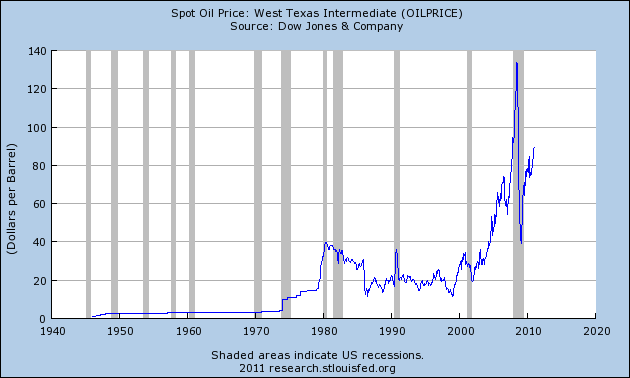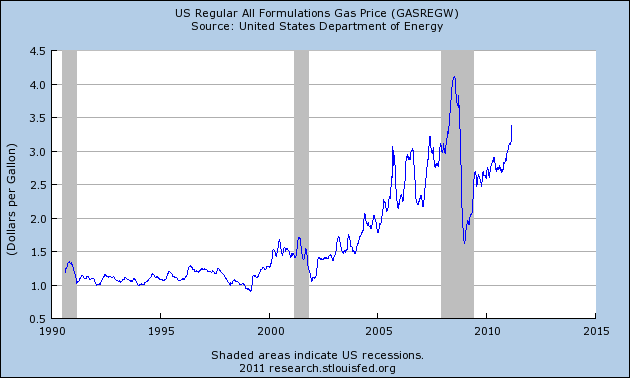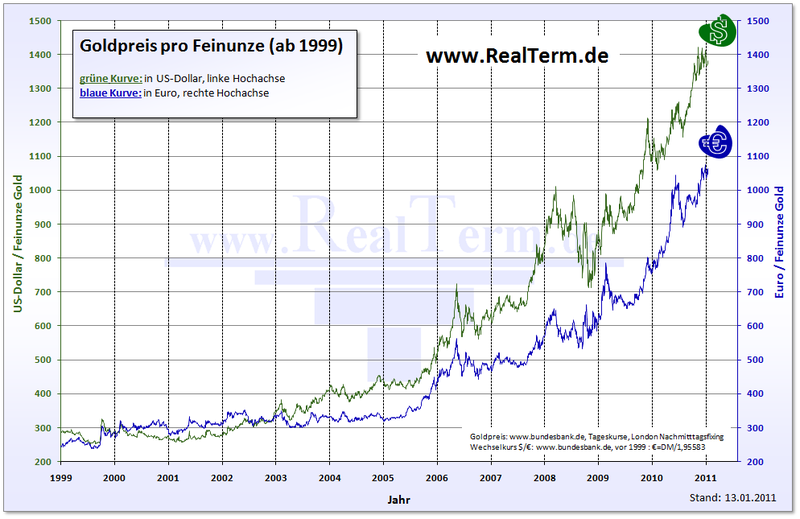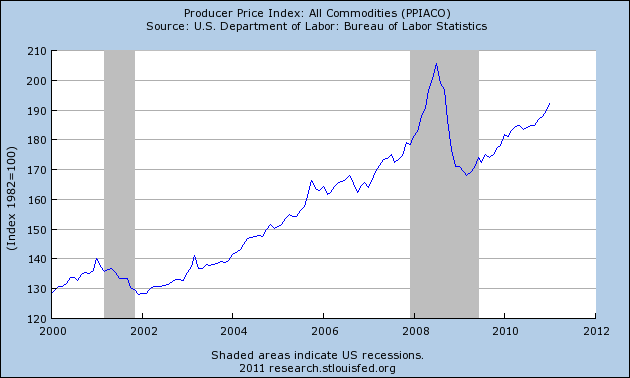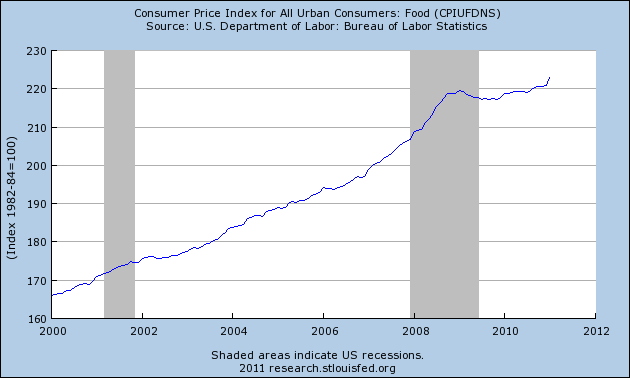 Despite what Federal Reserve Chairman Ben Bernanke says, rampant inflation is officially here. The federal government is constantly monkeying with the numbers to keep the “official” rate of inflation below 2 percent, but it is becoming very difficult to deny that the cost of almost everything is really going up these days. The American people are not stupid. They notice the difference when they go to the grocery store or stop at the gas station. The dollar is losing value rapidly now. The price of gold set another new all-time record today and is currently hovering just above $1430 an ounce. The price of West Texas crude has moved above 100 dollars several times recently and the price of Brent crude is currently above 116 dollars. These higher oil prices are really starting to be felt in the United States. The average price for a gallon of gasoline in the United States has now reached $3.38. There are some gas stations in the U.S. where the price of a gallon of gas is already over 4 dollars. But it is not just the American people that are feeling the pain. The global price of food recently hit a new record high and almost every major agricultural commodity has absolutely skyrocketed in price over the past 12 months. Meanwhile, Ben Bernanke just told the Senate Banking Committee that he really isn’t concerned about inflation at all.
Despite what Federal Reserve Chairman Ben Bernanke says, rampant inflation is officially here. The federal government is constantly monkeying with the numbers to keep the “official” rate of inflation below 2 percent, but it is becoming very difficult to deny that the cost of almost everything is really going up these days. The American people are not stupid. They notice the difference when they go to the grocery store or stop at the gas station. The dollar is losing value rapidly now. The price of gold set another new all-time record today and is currently hovering just above $1430 an ounce. The price of West Texas crude has moved above 100 dollars several times recently and the price of Brent crude is currently above 116 dollars. These higher oil prices are really starting to be felt in the United States. The average price for a gallon of gasoline in the United States has now reached $3.38. There are some gas stations in the U.S. where the price of a gallon of gas is already over 4 dollars. But it is not just the American people that are feeling the pain. The global price of food recently hit a new record high and almost every major agricultural commodity has absolutely skyrocketed in price over the past 12 months. Meanwhile, Ben Bernanke just told the Senate Banking Committee that he really isn’t concerned about inflation at all.
When it comes to inflation, the key is not to look at the official U.S. government numbers (they are highly manipulated) or how the U.S. dollar is performing against other major currencies (because they are all being devalued as well). Instead, you can get a truer sense of what is really happening to inflation by looking at what the U.S. dollar is doing against precious metals, commodities and other hard assets.
So are we experiencing rampant inflation right now? Well, just open up your eyes and look at these 5 charts….
1 – The price of oil is racing back up to record levels. The chart below from the Federal Reserve is a couple weeks out of date. As noted above, the current price of West Texas crude is about $100 a barrel….
2 – The price of a gallon of gasoline in the United States seems destined to hit a brand new all-time record at some point this year. Was it really just a few short years ago when the average price of gas in this country was about a dollar a gallon?….
3 – The value of most precious metals is very consistent over time. So when you see precious metals go up dramatically in price, it means that the dollar is being devalued. The price of gold just set another new all-time high and it seems destined to keep going even higher….
4 – The chart below from the Federal Reserve is a measure of the price of all commodities. These price increases are inevitably going to be passed along to consumers in the United States….
5 – After a couple of years of stable food price, the price of food is starting to take off yet again….
In fact, many analysts are warning that we could experience a major food crisis over the next couple of years. The global demand for food continues to grow at a very brisk pace, but all of the crazy weather we have been having around the world has caused some very bad harvests.
Unfortunately, the global price of food has gone up substantially in recent months and it is likely to keep going up very rapidly. Just consider the following five facts….
#1 The United Nations says that the global price of food hit another new all-time high during the month of January.
#2 The price of corn has doubled in the past six months.
#3 The price of wheat has roughly doubled since the middle of 2010.
#4 According to Forbes, the price of soybeans is up about 50% since last June.
#5 The United Nations is projecting that the global price of food will increase by another 30 percent by the end of 2011.
Ouch.
But isn’t there some good economic news?
Yes, there is, but before we cover it, it is important to keep in mind that in an inflationary environment almost all economic numbers go up.
For example, during the recent hyperinflation in Zimbabwe stocks went up like crazy and “economic growth” statistics were very impressive.
Why?
Because those numbers were measured in currency units that were being devalued at a blinding pace.
So please keep that in mind when you hear “good economic statistics” on the evening news.
The truth is that in an inflationary environment such as we have now entered into almost all economic numbers should be going up.
So what is the good news?
Well, last month all three major U.S. car companies reported strong sales gains. Sales of GM vehicles were up 49%, sales of Chrysler vehicles were up 13%, and sales of Ford vehicles were up 10%.
But just because a few pieces of good economic news come floating our way does not mean that we should forget all of the horrific long-term economic trends that are tearing this country apart.
The truth is that we are still a nation that is absolutely drowning in debt.
For example, it was just announced that China now owns 1.16 trillion dollars of U.S. government debt.
The borrower is the servant of the lender. We should never forget that.
Also, the U.S. economy is slowly but surely becoming of less importance on the global stage.
In 1985, America’s share of global GDP was 33%. Today, it is just 24%.
Our nation is rapidly being deindustrialized and we are becoming deeply dependent on industrial production from other nations.
Did you know that the new World Trade Center that is being constructed on the site of the September 11, 2001 attacks is going to be made from German steel and Chinese glass?
That says a lot about where we are at as a country.
We have allowed so much of our industrial infrastructure to be exported to China where workers slave away in almost unbelievable conditions.
A reader named Rish recently described what things are like over there….
As a product developer I went to china and saw the way the factory workers lived and worked in person. 50$ a month is about right, but if you are a skilled quality control expert you might make as much as 150$. at least this was true about 2 years ago the last time I went. The barracks were pretty meager, bunk beds with just plywood, no mattresses, if you wanted you could go to a store just outside the factory gate and buy a thick comforter that they sell as a “mattress” .
It will be interesting to see how the next few years changes the face of the USA. Who knows? if the unemployment rate and lack of jobs keeps going and enough people become homeless, we might become the next Bangladesh, and people will be lining up of the 30 cents an hour corporate factory jobs, and living in barracks just like those…
The only way the U.S. has been able to “thrive” during this deindustrialization is by borrowing gigantic amounts of money. But all of this borrowing is slowly but surely destroying the U.S. dollar, and we are getting closer to the point of absolute catastrophe.
Peter Schiff recently shook folks up when he talked about these issues during a recent interview on CNBC….
But it is not just the United States that is printing tons and tons of money. All of the major industrialized nations have been firing out gobs of currency. That is a huge reason why so many investors have been racing to get into hard assets recently.
Now Ben Bernanke and other top Federal Reserve officials have been dropping hints that more quantitative easing may be necessary.
Unfortunately, just like with any other addiction, once you give in a few times it becomes easier and easier to engage in destructive behavior. Now that the Fed has gotten a taste for quantitative easing it is going to be really hard to stop.
Nor can the Fed stop at this point. If they did it would be disastrous for the U.S. economy. But if the Fed continues on this reckless course it will make the eventual collapse of our economy even worse.
Under our current debt-based system there is no way out. The Federal Reserve can attempt to put off the inevitable for a while by pumping up the debt bubble even more, but at some point it is going to burst.
When that happens we are going to be facing a financial crisis which will blow what happened in 2008 completely out of the water.
So enjoy these good economic times while you still can. This is about as good as things are going to get from here on out.
